- To better explain exactly what and why these creatures are,
- Provide lots of pictures of the different types depicted from the Heian Period to modern-day anime, and everything in between,
- Share the stories and images behind many yōkai and cultural instances that are hard or impossible to find online in English, and
- To answer questions about yōkai as best I can.
First off I'll give you a basic dictionary paragraph about yōkai.
A yōkai can refer to a number of things, from a supernatural creature, being, ghost, demon, spirit, happening, monster, or even a human, animal, object or any worldly thing that exhibits or acquires supernatural power or appearance. For the sake of clarity, I generally view supernatural Japanese things in three major categories: ghosts, gods/demons, and yōkai. The 'ghost' category (yūrei) covers spirits, spectres, visions, dreams, or any sort of supernatural apparition involving a human. Gods and demons refer to legends in Shinto, Buddhism, or any other religious belief or figure adapted into a moderately well-known cultural phenomenon. These two categories I will go into with greater detail in the next Kagrra, installment.
The yōkai I am referring to are 'supernatural creatures'. They will be vengeful, monstrous in appearance, or even just harmless animal-type-things playing tricks. They also can include certain forms of ghosts or demonic presences, but this would involve the ghost or demon being formed by a human who had undergone such a legendary tale that it caused them to mutate into a very specific form of monster, instead of simply becoming a ghost or demon.
Yōkai are hard to explain in Western terms, if there is an equivalent, I'm afraid I don't know about it. We view ghosts, demons and monsters differently in Japan, and I don't know any cultural significance in the West or America that would be a direct descendant or cousin of yōkai. I could compare them to some sort of cryptozoology, like Bigfoot, Nessie, vampires, werewolves, or Robert Pattinson: something you know about, but never really see, despite having a vague idea of what it looks like, but you'd know basically where and how to find it if pressed. Or you might compare it to supernatural or fairy tale creatures, like elves, fairies, goblins, talking animals, or any sort of distinctive imaginary creature found in local legend or lore, with their own distinct species and mannerisms between them. I don't claim to know everything about this sort of comparison, but to me, yōkai seem to have their own little category, because I can't think of a real Western equivalent to the specific significance of yōkai in Japan. If you can think of one after reading this, I'd be very appreciative to hear it.
Yōkai mainly revolve around cultural learnings and tales instilled in us, superstitions and rituals and fears about specific creatures that will come up in daily life, in a great number of movies, books, video games or popular media, even going so far as to be a mascot of a company selling anything you can think of, having food items named after it, or just to represent something about a specific person's store, personality, house, or interests.
You probably know about several yōkai without even having heard the term before. These popular examples that are a bit more familiar to Western eyes include, but are not limited to: the kappa, the tanuki or kitsune, tengu, the chochinōbake or karakasa, and and the kodama, just to name a few.
I won't go into these specific yōkai because they are so well-known and there is much English-language information about them to be found online. My next entry will focus on some of my favourite or hard-to-find yōkai, but this one will take the in-between road. It's all about semi-popular yōkai you may have seen before but not known about, or will learn about and soon see often, as well as lots of photos of their most popular instances in the past and modern-day popular media.
If you're just starting to learn about yōkai, and would like to learn more, the best places I can recommend are as follows:
Search for "hyakkiyakou" or 百鬼夜行. This being a Kagrra, song, I'll explain all the meanings of it in that next entry, but basically it refers to the Demon's Night Parade, a march of all types of demons throughout the streets of the Capital, or the entire country, depending on who you're listening to, which I mentioned in my last yōkai entry. The origin of many yōkai are in these famous ukiyo-e, a vast amount of which was drawn by many different artists of varying popularity. It was basically the "Madonna and Child" of the Edo Period; everybody was drawing it to get some sort of recognition or put their own imprint on the artwork.
Watch anime. Kids love spooky or clever little creatures, and films by Studio Ghibli and Miyazaki Hayao are as good a place to start as any. Spirited Away and Pon Poko are my favourites for this.
Read manga. It's the same as above, but if you remember from my entry on Yoshitoshi, manga goes way, way back, even back before Urusei Yatsura, if you can believe that. Lots of prints and drawings and stories about yōkai were extremely popular in the Edo period, which you'll see below. Another great manga (and anime) is GeGeGe no Kitaro, by Mizuki Shigeru. If Toriyama Sekien is the best-known artist, writer and creator of the past, Mizuki Shigeru is certainly his modern-day equivalent. In addition to Kitaro, Mizuki writes many in-depth books on yōkai, and his home-town has a museum and road dedicated to him, with many statues of all of his yōkai lining the street.
Watch the movies that started "it all". Back in the late 1960s, the film company Daiei made a trilogy of movies about yōkai for children, but it really started the interest in yōkai back up again, and they are in the process of being remade by Miike Takashi. I haven't seen the new movies, but obviously the originals are a favourite of my yōkai-obsessed mother, whose constant screening of them for me as well as lectures have probably made these yōkai entries of mine make me sound like a little yōkai encyclopedia. I place the blame on my mother entirely. Regardless, the movies are classics in a classically bad way, and are a must-see for anybody who wants to learn about yōkai, watch a Neverending Story-style children's fantasy movie, or just watch really corny badly-costumed Japanese cinema. They're available on Amazon for American/Canadian audiences with English subtitles as a three-film set or separately (the three films are titled Yokai Monsters and individually are Spook Warfare, One Hundred Monsters, and Along With Ghosts).
There are many different artists, media, films and products that feature yōkai, but my favourites are these, in addition to the ones I'll describe below, so let's get to it!
Yōkai In Legend, Ukiyo-e, and Modern Art
Apart from those popular yōkai I mentioned above, the most well-known and even the mascot of yōkai is the Gashadokuro (がしゃどくろ). You've probably seen him before. He's a big skeleton. That's all. Just a huge fucking skeleton.

This is one of the most famous ukiyo-e depicting a yōkai, and it is by the very famous and popular artist, Utagawa Kuniyoshi (歌川 国芳). This photo is so striking because of the extreme detail Kuniyoshi put into the work, as well as possibly being the first print seen in Japan to portray a skeleton with such medical accuracy. It is said that he studied the medical journals of Europe to draw the Gashadokuro.
A Gashadokuro, or "starved skeleton", is said to be made up of the bones of the damned, wronged or starving, or a large portion of decomposed bodies that were not properly cleansed, respected or buried, and they will all gather together to form the enormous skeleton. To take its revenge, the Gashadokuro will eat humans, incorporating the bones of its victims into itself and growing larger. The only way to avoid it is to run away immediately if your eyes start to burn or your ears start to ring and you feel an earthquake coming. These are said to be the warning signs that it is approaching. To defeat it, you must listen closely to the eerie voices ringing in your ears, for they will tell you where to find a buried skull, the so-called "brains" of the operation that will vanquish the Gashadokuro if split open and destroyed.
The ukiyo-e above is depicting a famous legend of the Gashadokuro, one that is said to be true, and therefore very popular in kabuki. If you'll remember the few times I've mentioned the Heian period, you will recall the names Fujiwara, Taira and Minamoto. These are basically all the names of note in the Heian period, because they were the most high-up in the court and scandalous and all anybody cared to talk about. The particular story, depicted in the kabuki Masakado, focuses on a young warrior by the name of Mitsukuni, a vassal of the imperial Fujiwara clan. The legend goes that a warrior of the Taira, Taira no Masakado, had staged a coup against the Fujiwara, and was killed. He was beheaded, and his skull was put on display as a warning against rebels to the Fujiwara. It was said that his skull would laugh manically, groan angrily, or mock passers-by for several weeks as it was displayed. It then flew off of the post and went in search of Masakado's body, where it landed and was buried. Incidentally, this is the location the voices will whisper to you to go find the skull and destroy it. It's in Tokyo.
To make a long story short (too late), Mitsukuni awakens to find a beautiful courtesan tending to him. She tells him that she fell in love with him at first sight upon having seen him from afar at a party, but he becomes suspicious, for the style of courtesan she is dressed as are unable to leave the pleasure quarters at night, and he doubts her story. He then does a dance for her, re-enacting Taira no Masakado's final moments. She goes into a blind rage and reveals herself to be Masakado's daughter Takiyasha, and that she had been praying at a shrine for vengeance and received dark magical powers. She then disappears in a puff of smoke and re-appears outside the capital, guiding or even riding atop an enormous Gashadokuro meant to destroy the Fujiwara clan and the imperial court. The print depicts the scene of Mitsukuni reacting to the Gashadokuro summoned by Takiyasha.
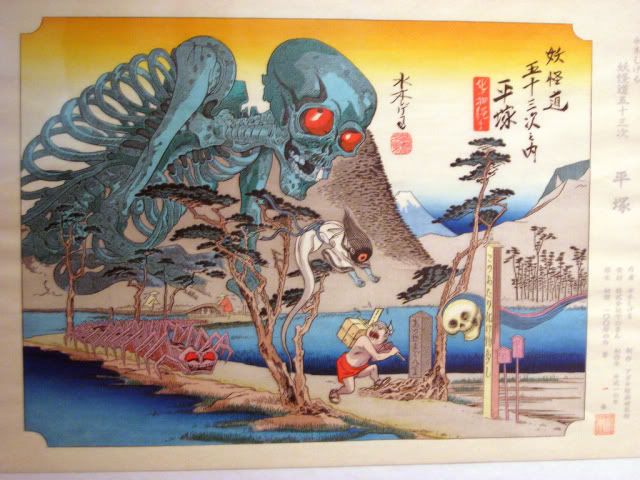
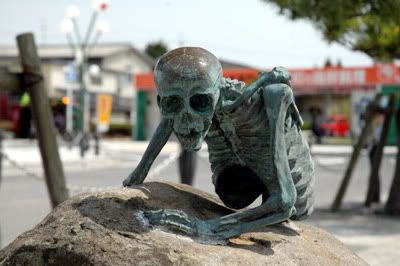
Here is Mizuki Shigeru's version of a Gashadokuro, as well as a statue located on his yōkai road.
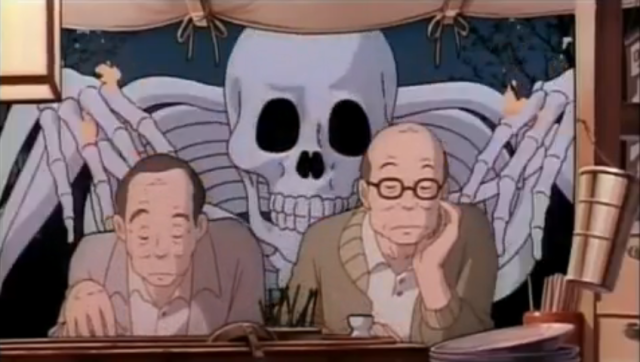
In Studio Ghibli's Pon Poko, a Gashadokuro appears during their Hyakkiyakou.
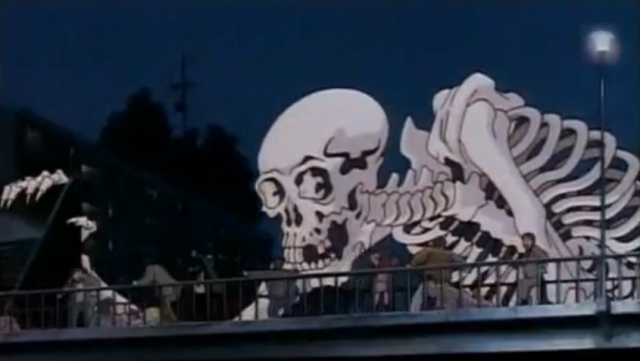
This is obviously an homage to Kuniyoshi's famous work.
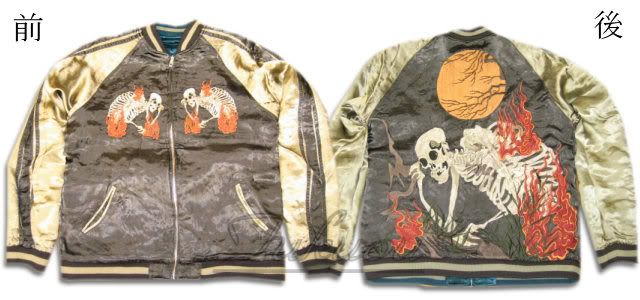
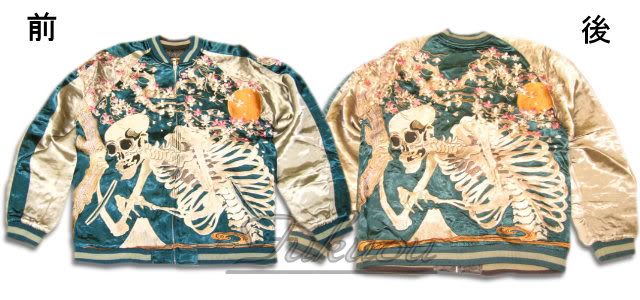
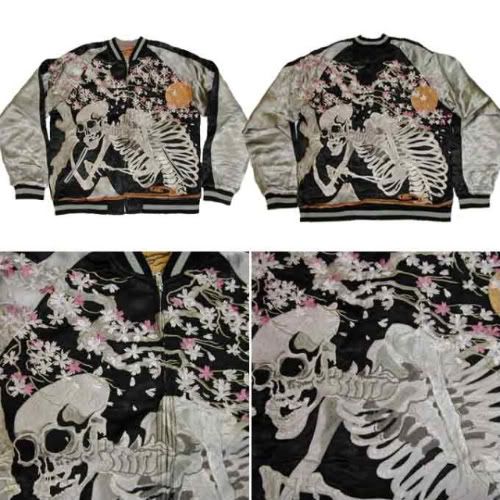
For some reason, Gashadokuro are an extremely popular motif on silk jackets.
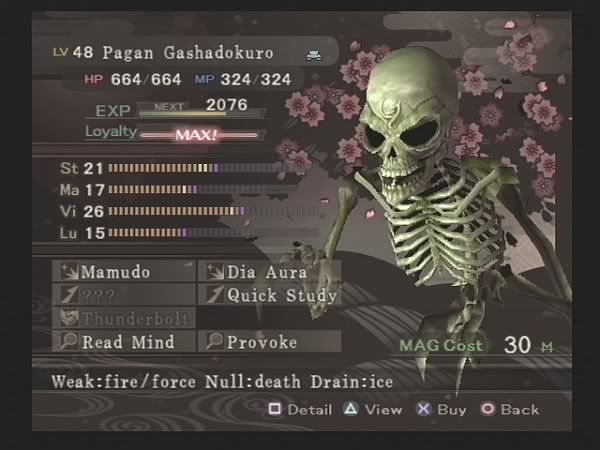
This is a depiction of the yōkai in one of my favourite video games of all-time, Shin Megami Tensei's Devil Summoner featuring Kuzunoha Raidou. I really like their style, so I'll be using many of the demons from this game in the modern art examples.

Another type of skeletal yōkai is the Utai-gaikotsu (歌い骸骨), or "singing skeleton", a continuation on the tale of Taira no Masakado. It is said that if a person is killed in a very violent or unjust way, evil energy will possess the deceased's skull, and it will float along following those who wronged it, singing a terrible song about the manner in which it was killed, or to warn others. The tale goes that two merchants robbed a tradesman and stole all of his money and wares, claiming it as their own. One day, after becoming very rich, they were walking down the street and heard a beautiful singing voice. Locating it coming from the bushes, they found a skeleton singing a song. It introduced itself to the merchants and asked if they liked its song. The merchants, never to miss a money-making opportunity, said it was wonderful, and ran off to tell others of the singing skull, and to charge money to see it. The people said they didn't believe such a thing, so the merchants produced the skull. The skull began to sing a song about how the merchants had killed it and stolen all of its money, and the merchants got was was coming to them thanks to the skull's warning.
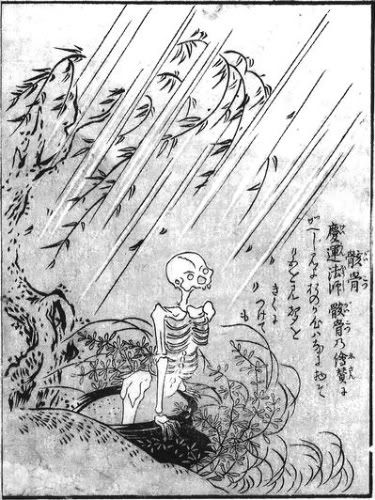
Toriyama Sekien (鳥山 石燕) is an extremely famous artist on the subject of yōkai. He made an attempt to catalog and paint all yōkai, though he also invented some of his own, several of which are plays on words, puns, or popular jokes of the day made into yōkai form. This is his haunted skeleton.
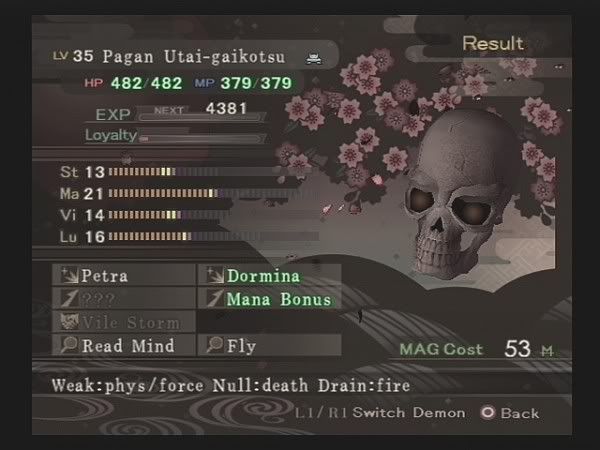
This is Devil Summoner's Utai-gaikotsu.
Another popular yōkai that you most likely have seen but may not understand is the Rokurokubi (轆轤首). Literally, this means "potter's-wheel neck", which invokes the image of someone with marks on their neck like cracked clay haphazardly molded by a potter. If you haven't figured it out, the reason the neck has these stretch marks is because, well, it's a person with a really stretchy neck.

Since they are so popular, their stories are similar and well-known, but they are iconic and freaky enough to warrant the cover of the Yōkai Monsters movies, despite having only a small part in just one of the films...

and on the cover of foreign Meiji-period writer Lafcadio Hearn's tales of the Japanese supernatural, though through a translation error the Rokurokubi is confused with a Chinese variant.
There are many legends and tales of Rokurokubi, since they are believed to be caused by several different situations, including out-of-body experiences or in fact just being creatures that greatly resemble humans but have the ability to stretch their necks like snakes and travel around in search of the blood or life essence of a human. These monsters live as humans and often marry so as to have a definite blood/ki meal each night, and blend in as a woman wearing many layers of kimono or some sort of scarf or draping around the neck to hide the striations from the neck-stretching. Other stories cite women who became or lived as normal humans, not knowing themselves that they were yōkai, and would wake up each morning with neck pains from "shifting on their pillows in the night" (the traditional pillow rests under the neck), or being very achy and disoriented from having strange dreams. These dreams are troubling because they seem like out-of-body experiences since they are able to describe things they witnessed elsewhere while travelling via snake neck, or else they are just made dizzy from the strange vision of the head bobbling and twisting around as it moved and became ill.
They are often discovered in amusing situations, often growing tired or waking up to have their neck stretched out so far that their head is resting on the other side of the city, or draped over or stuck in something. Often, they are involved in stories of a man waking up very tired after his first night with his new wife or an evening with a prostitute, and discovering that he is so exhausted because his blood or life essence has been drained by his companion, who is a Rokurokubi! It's obviously not for any other reason, really. The Rokurokubi are also portrayed as pranksters like many less-threatening yōkai, enjoying to gnaw on insects or morph their faces to resemble that of a demon in order to frighten children or drunks so that they can have fun messing with humans but their secret will be safe.
There is a story my mother told me that has been passed down through many generations of my family. According to a great-great-great-etc. Grandfather, he was walking with two of his friends through the town late at night (where it is specified that they had not been drinking, but probably they had...), and they heard a lovely woman's voice beckon them to a window. Naturally, as I would have, they went to go see what was up. Uninformed of the utai-gaikotsu story, they asked if she needed help, and she peeked up at them from over a fence. She insisted that she was lonely and had no-one to drink with and invited the men into her home (so you probably have some idea what part of town they were in...) They walked along the fence to get into her home, and she walked along with them, but suddenly one of my ancestor's friends realized that they heard no sound of her walking, and since it was such a cool night, they should have heard the many layers of her kimono shuffling as she walked along the pathway on the other side of the fence. Suddenly, my great-etc. Grandfather declared that she was a Rokurokubi and, despite hearing this slander, the woman said "Please hurry!", but the men had frightened themselves by now and ran away to a shrine, where he reported the happening to a priest there, who claimed he would take care of it, but they later found out that there was no report of a Rokurokubi in town, but instead an incident where a couple of drunks came in and bothered the priest. He wrote and told the story that he was not in fact, drunk, but if you know my family I guess you know what to expect from the lot of us being disorderly yōkai-obsessed loons. So it's not just me.
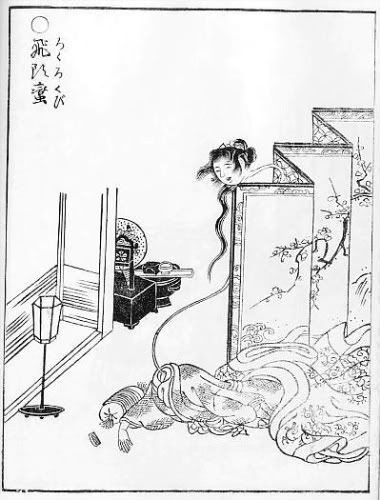
This is Sekien's Rokurokubi. Like I told you, many yōkai stem from puns or jokes of the day, and it's entirely possible that the Rokurokubi tales developed because of a popular saying. A person who is often anxiously awaiting something is said to be "sticking their necks out in anticipation", the English equivalent something like "waiting on tenterhooks". Thus, someone often sticking their neck out, or a particularly nosy woman in everyone's business can be seen to have a drifting neck to get into everyone's conversations, and thus the image of the Rokurokubi as a traditional lady who would be very interested in the affairs of others, while still attempting to live a normal life and hide her nosiness could have inspired the stories of the Rokurokubi as a yōkai.
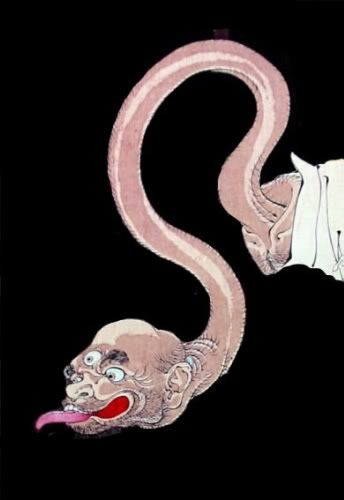
Of course, Yoshitoshi's most famous Rokurokubi is a man.
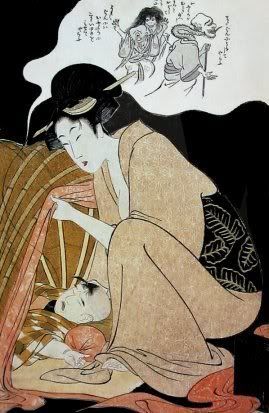
And in this work by Kitagawa Utamaro (喜多川 歌麿), a little boy is having nightmares about a one-eyed acolyte (more on them later) and a male Rokurokubi, who see that his mother has come to comfort him, and conspire to continue to haunt his dreams if she does not wake him, and then go and bother her dreams later in the night.
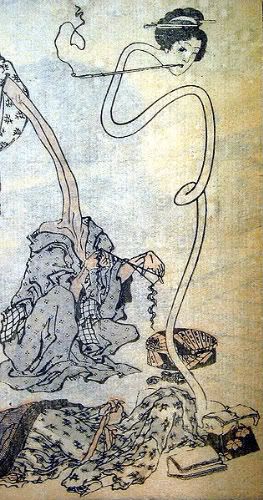
This is a Rokurokubi by one of the most internationally famous ukiyo-e artists, Hokusai.
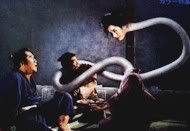

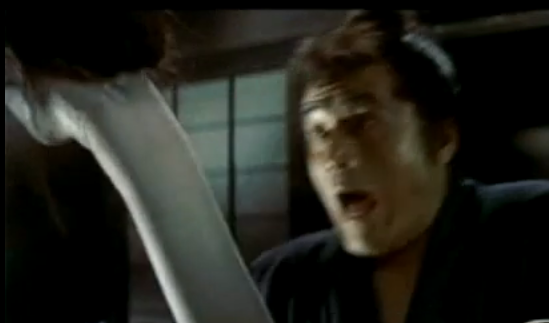
Here are some of the most well-known images of Rokurokubi, from the 1968 Yōkai Monsters film, Yōkai Hyaku Monogatari.
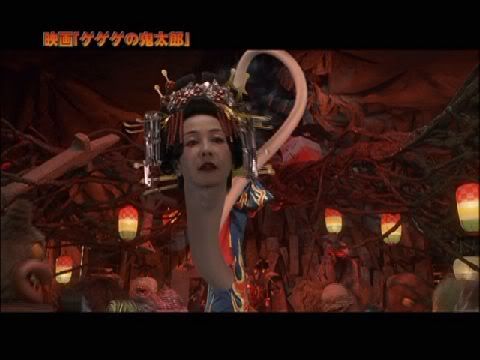
Here is a less low-budget version from the live-action movie of GeGeGe no Kitaro.
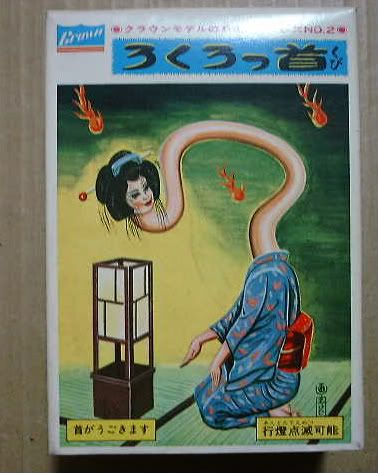
This is a model of the Rokurokubi you can build.
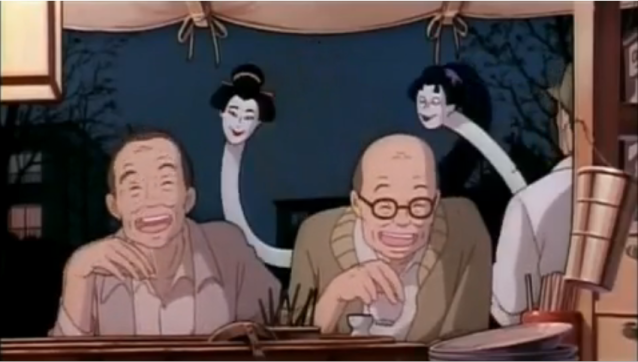
Two Rokurokubi bothering those poor gentlemen in Pon Poko.
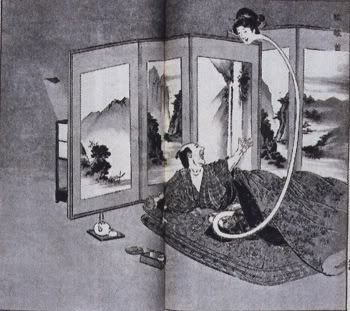
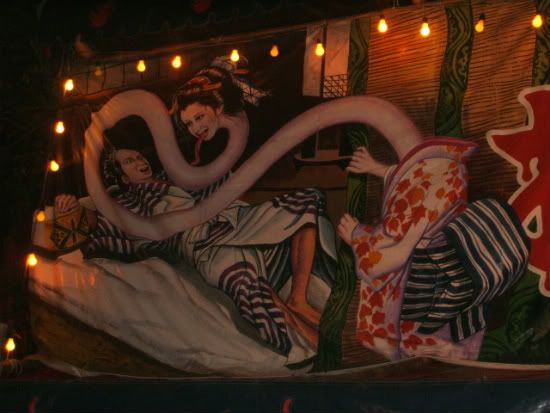
Several of my favourite images of Rokurokubi.
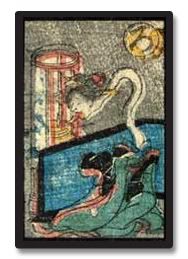
And finally, this image comes from the Obake Karuta. In the Edo period, when yōkai tales and sightings ran rampant, a popular pastime was playing card games, which is still popular today, especially on holidays like New Year as I mentioned in my last entry. One of the most popular series of trading cards, or karuta, at the time was the Obake Karuta, a set depicting a different monster in accordance with each syllable of the Japanese alphabet. For example, the equivalent would be something like "A is for Abominable Snowman, B is for Basilisk, C is for Chimera, etc..." Rokurokubi represents "ro". I'll post each yōkai's karuta when applicable.
One of the more traditionally famous yōkai is the Tsuchigumo (土蜘蛛), which means "the Earth Spider". The Tsuchigumo is generally depicted as an enormous spider (think Aragog from Harry Potter), but many artists and stories also describe the Tsuchigumo as having the traits or appearance of other animals as well, for example, with the head and fur patterns of a tiger, a snake's tongue or a long tongue like a chōchinobake, three eyes, or horns or antlers like a deer or demon. Some stories say that the Tsuchigumo was the pseudonym of a bandit who lived in the mountains, and that he fed on human blood. It is also an extremely popular character in kabuki. At this point you'd probably assume that, when it comes to kabuki, even an enormous demonic spider beast would have to play second fiddle to the exploits of some notable warrior from one of the Heian period clans, and you would be right! But this particular man has many legendary stories that are depicted in kabuki, so many that there are at least six different kabuki I can think of off the top of my head that focus on the Tsuchigumo legend alone. The man in question is Minamoto no Raiko, who served the Fujiwara.
The popular story goes that Raiko was very ill, and four of his retainers were keeping watch over him during his convalescence and playing Go. The Tsuchigumo, sensing that Raiko was in a state of weakness, acted to kill him. He summons many yōkai to battle, and uses goblins, demonic women, and even Rokurokubi to seduce or distract Raiko's four retainers as he materializes in Raiko's room. Raiko wakes up and cuts of the leg of either the Tsuchigumo or the leader of the ambush, depending on the tale, and all of the monsters disappear. His four retainers, who are popularly known as the Shitennou, or Four Heavenly Kings of Buddhist lore (a title reserved for extremely loyal and valiant quartets of warriors, Tokugawa Ieyasu also had his own Shitennou) follow a trail of blood from the injured monster's leg back to a mountain cave, where they find the Tsuchigumo and slaughter it, resulting in the immediate recovery of Raiko. This version is very popular in ukiyo-e, and will often feature the four retainers and a Go board.

Please look at more of these prints, as well as in-depth information and trivia at this site.
There is also another retelling of the story, which focuses more on Raiko himself, and is very notable for the amazing battle scenes.
The legend generally begins with Raiko, known for his valor and skills in battle, seeking out the cause of a strange disturbance in the mountains. In his search, he comes across another yōkai, and travels on to eventually happen across a beautiful woman who seduces him. Soon after he begins to become intoxicated by her, he notices that she is wrapping him in spiderwebs and attacks her, but it turns out that she was an apparition of a Jorogumo conjured by the Tsuchigumo. He raids the Tsuchigumo's hideout and they have an amazing battle, resulting in the gruesome death and glorious victory of Raiko.
Tsuchigumo is a great Noh play, and if you've never really seen Noh before, it has a bit in common with Kabuki, many popular tales and legends are shared between the two, and it features lavish costumes, dancing and music as a traditional play, but unlike Kabuki, it focuses more on the traditional tales and depictions in a fixed manner, each movement and performance very minimalistic and full of allegories and metaphors, often pantomimed. As it was reserved for the high courts of the time, unlike Kabuki, Noh does not feature very graphic fights and popular new stories of the time, and many of the actors will wear masks. In Tsuchigumo, Raiko is visited by a monk who is actually the Tsuchigumo in disguise, and Raiko quickly discovers this and injures it, chasing the trail of blood back into the mountains as in the first story with his retainers. This drama is very popular because, at the climax of the play, the Tsuchigumo shoots spiderwebs onto the warriors, and sometimes even the audience! If you ever have trouble staying awake at times, you should do an image search for the Noh play Tsuchigumo, and I guarantee you'll be unable to rest for weeks.
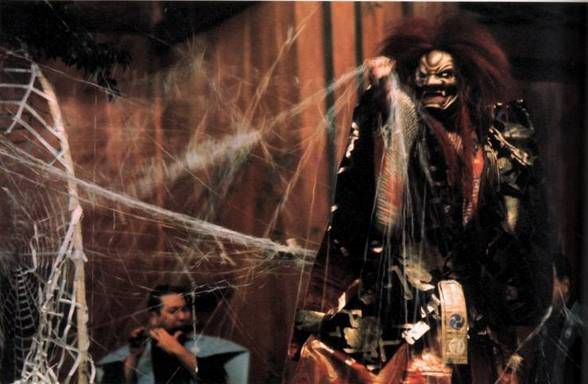
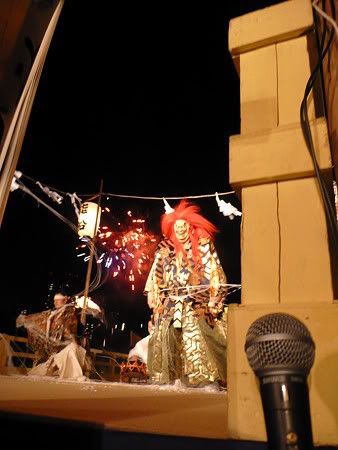
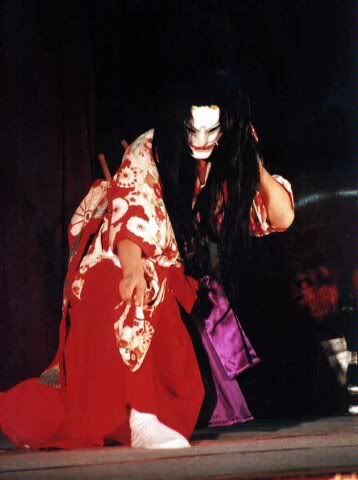
This site also has a slideshow of the play, so if you're interested or have never seen Noh before, it's a good place to start.
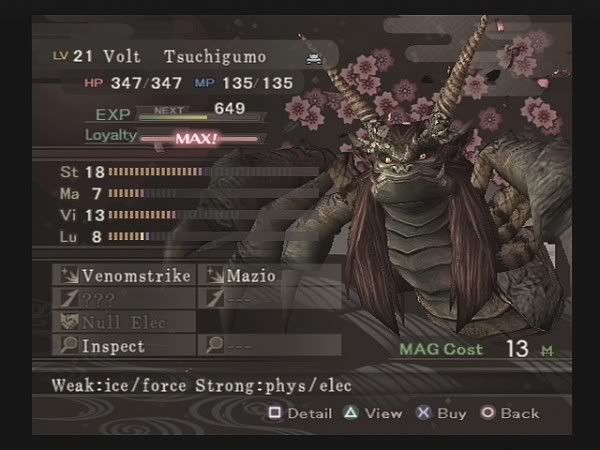
Here is Devil Summoner's Tsuchigumo.
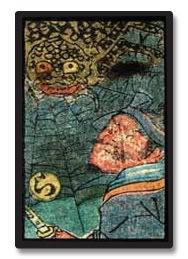
The Obake Karuta for "ra", featuring Raiko with the Tsuchigumo.
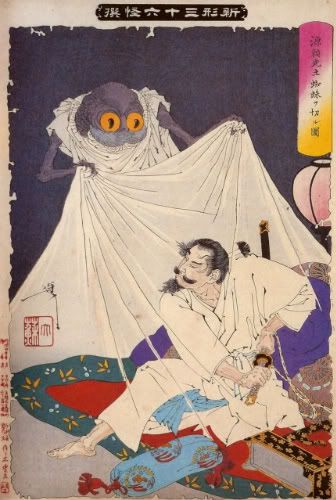
Yoshitoshi's Tsuchigumo attacking Raiko in the night.

Sekien's Tsuchigumo.
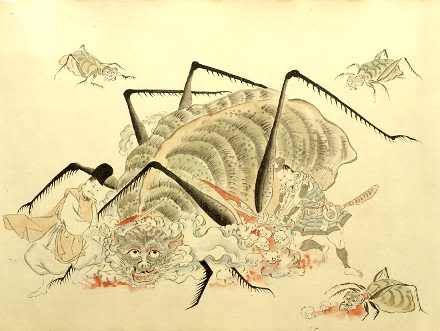
This image represents the Tsuchigumo with the tiger's head and markings.
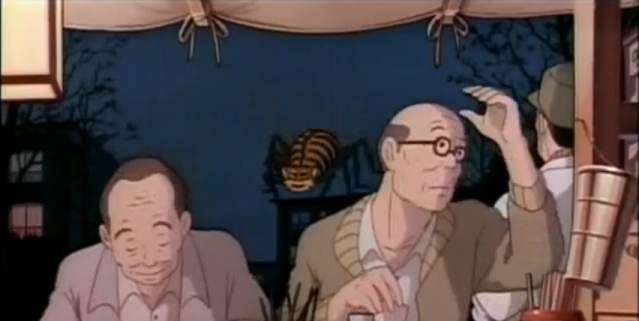
It is seen here in Pon Poko.
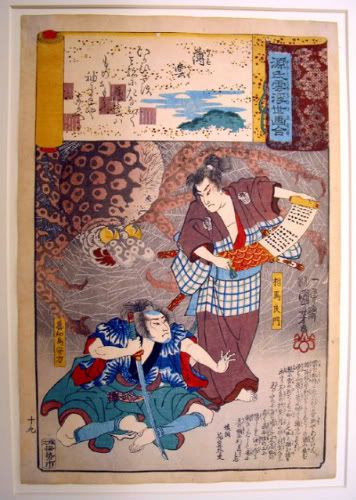
Another yōkai similar to the Tsuchigumo, or sometimes depicted as one of his minions, is the Jorogumo (女郎蜘蛛). This literally means "the prostitute spider", but it also can be written to mean "the entangling woman". Jorogumo are said to be the metamorphosis of spiders who gain supernatural powers after living for a certain amount of time (much like the nekomata and several other creatures). The most popular story depicts a man who heard the beautiful sounds of someone playing the biwa in a seemingly abandoned shack. When he peered inside, he saw a beautiful woman who invited him in to hear a special song she would play for him. As he listened, he fell into a daze and she wrapped him in spiderwebs and ate him.
There are also several other tales focusing on the Jorogumo, as the story of a demon disguised as a beautiful woman to seduce and kill and/or play tricks on men is a very popular one. The most famous of those stories focuses on a lumberjack who was cutting trees near a pond or waterfall, and his feet were suddenly wrapped in spiderwebs which began to drag him towards the water. He used his axe to break free and tied the web around a stump, which was dragged into the water instead. There is another more romantic tale where this takes place, and another lumberjack, not knowing or heeding the story to stay away from the water, goes and cuts down more trees, where he falls in love with the Jorogumo and goes to great lengths for them to be together.
Another popular theme of the "beautiful woman who is secretly a demon" stories is the theme of a woman appearing with a baby. Usually she will pawn the baby off on a warrior or fisherman or whomever the story is focusing on, and wander off to kill herself or simply disappear. The baby will either grow to an enormous size and crush him or be revealed to be a monster and kill the man who holds it. In the Jorogumo variant, she will appear holding the baby and give him to the man, and as she wanders off, the man will look down at the baby, who will instead be an enormous spider's egg sack, which will burst open and let loose a multitude of spiders who overtake and kill the man.
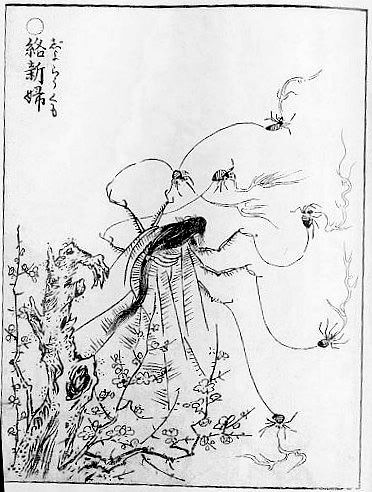
Sekien's Jorogumo.
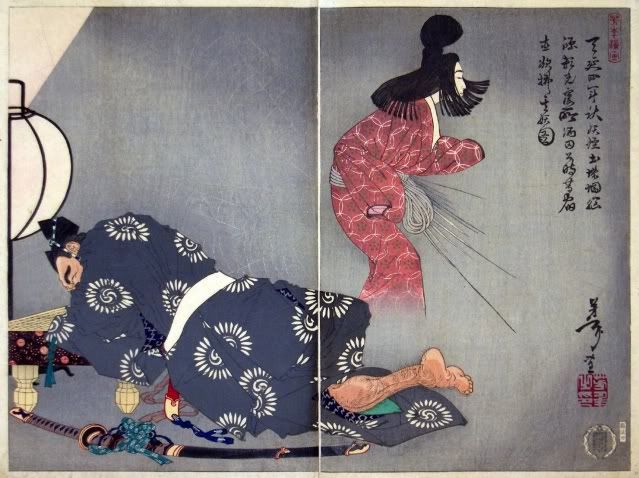
Yoshitoshi depicts the Jorogumo appearing to Raiko's retainer, as in the Tsuchigumo story.

Jorogumo is a character from the manga and anime series xxxHoLic by CLAMP.
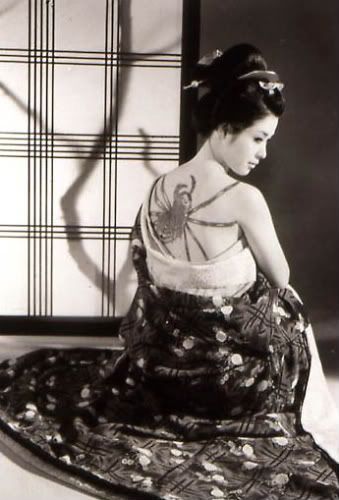
The Jorogumo appears in many older movies as a huge reveal since the fear of the monster and the appearance of a half-naked woman was easy fright and outrage at the time.

They also appear in newer movies for different reasons.
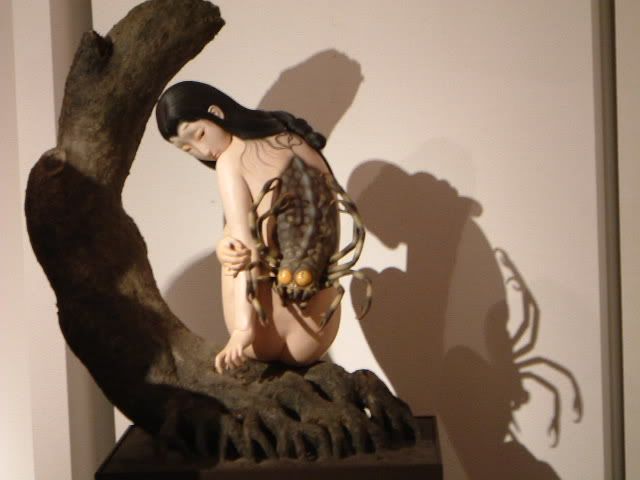
This sculpture by Arai Ryo is made out of papier-mâché.
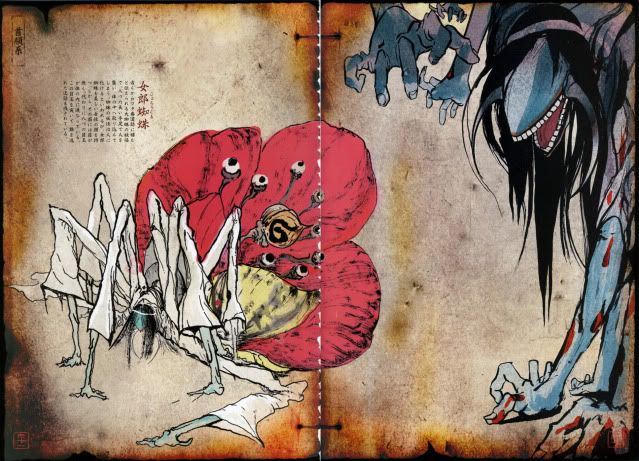
The Jorogumo also appears in the video game Ōkami.
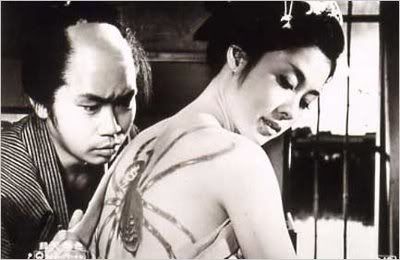
Men everywhere live in fear that someday when they get their lady-friend to take her kimono off, an enormous spider-beast will burst from her back and eat them. Really, it's not just me.
The last relatively well-known yōkai I will talk about today is the Wanyudo (輪入道). As the name suggests, he is a "wheel priest". The origin story of the Wanyudo dates back to the Heian period, so the ridiculously adorable tale makes it one of my favourites. The story goes that there was a tyrannical daimyo who would abuse the peasants. One day, the villagers were enjoying an ox-cart tour of the city, and they ran over the wicked daimyo and killed him. Is that not the most hilarious, Heian period sort of story you ever heard? Anyway, the deceased daimyo flew into such a rage at his death and the manner in which he had been killed, that he became a Wanyudo, his disembodied head the center of a ghostly oxcart wheel ringed with fire. Amazing! He would then roll through the streets collecting lives and souls of the townspeople he so hated (or, in some tellings, he became an acolyte of Hell and would collect souls and bring them to the underworld), and as he rolled through, any who dared to look at him would have their souls ripped out, or else those who got in his way would become tangled in the spokes of the flaming wheel and burn to death.
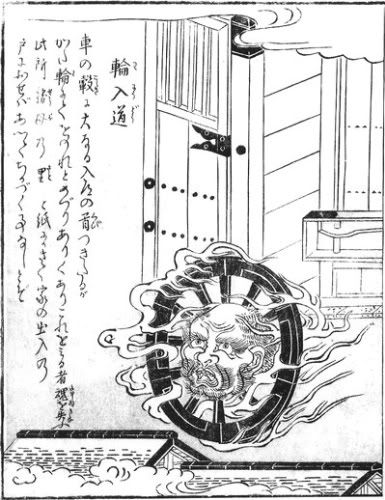
Sekien's Wanyudo.
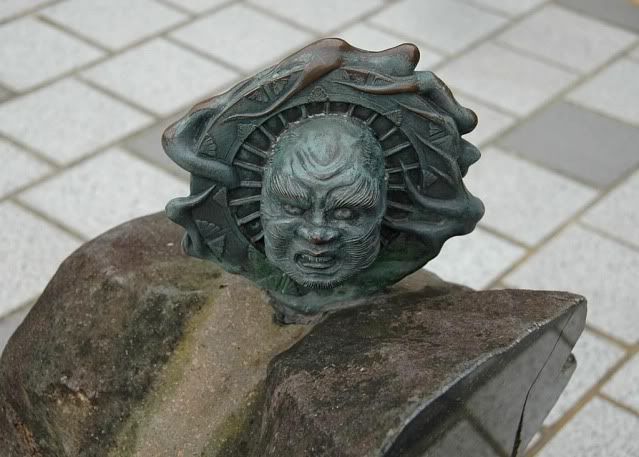
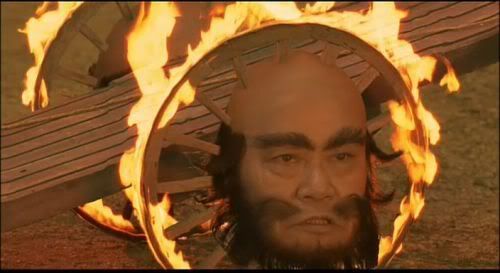
A Wanyudo on Mizuki's Yōkai Road, as well as a depiction of it from the GeGeGe no Kitaro movie.

This is the Wanyudo's karuta. His character is not a hiragana, but the kanji for "Kyo", the capital, specifically Heian-kyo, the Heian capital of Kyoto where the Wanyudo roams.
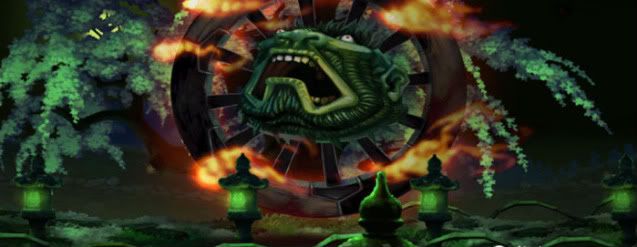
Wanyudo makes an appearance in the recent video game Muramasa: The Demon Blade.

A Wanyudo steals the soul of a woman who dared to look at him from the Shokoku Hyakumonogatari, stories of strange things from the Edo period.
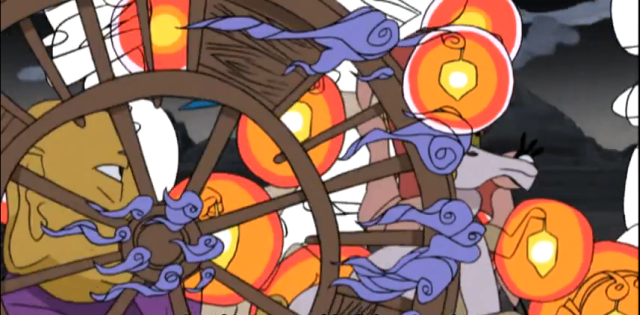
A Wanyudo rolls by during the Hyakkiyakou scene in the anime xxxHoLic.
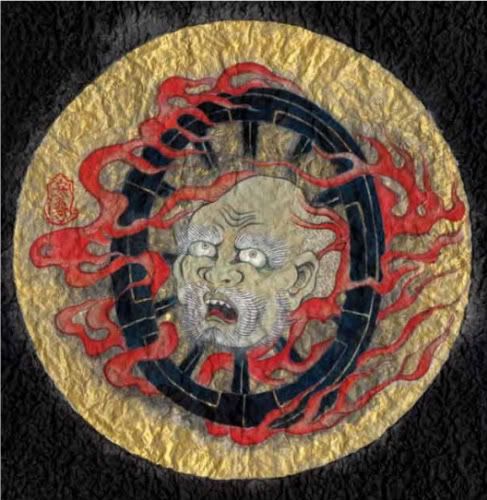
My favourite image, because I feel it is the embodiment of the Wanyudo. That is exactly how I would feel if I got run over by an ox-cart carrying peasants having a little sightseeing tour of the capital.
Wanyudo fall into a "category" of similar yōkai called Katawaguruma (片輪車), or "disfigured wheels/vehicles".
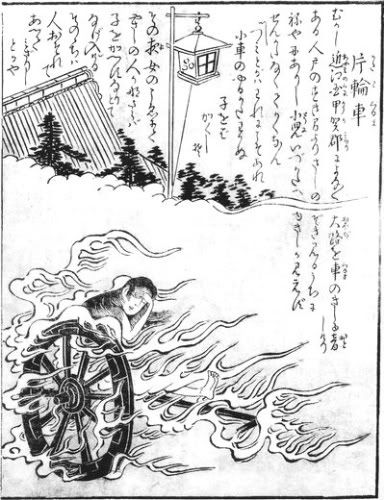
This is a female Katawaguruma by Sekien.
Another type of Katawaguruma is the Oboroguruma (朧車), meaning "gloomy car" or vehicle. The tale differentiates from the Wanyudo as it is seen as more "modern", and does not focus on the Heian capital. It is said to have originally manifested from the angry spirit of a peasant woman who was run over by a carriage. With the Oboroguruma, the entire vehicle is manifested, with the woman's gruesome face in the bamboo shade at the front of the carriage. The "oboro", meaning gloomy or misty, ties in to the legend that the haunting squeals of oncoming wheels will resound throughout the streets on foggy nights, and those who hear it will soon come face-to-enormous-carriage-face of the Oboroguruma. The Oboroguruma seems to feed on or absorb the tormented souls of those who have died over arguments about vehicles, and seek revenge.
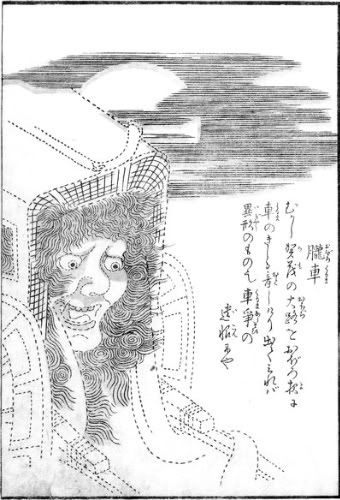
Here is Sekien's Oboroguruma.

In Devil Summoner, as well as in many yōkai stories taking place in modern times, the outdated ox-cart is changed to represent a demonic car or even motorcycle. In this particular game, the Oboroguruma feeds off of the tormented soul of a rickshaw puller who is losing business as the city experiences modernization and he loses business.

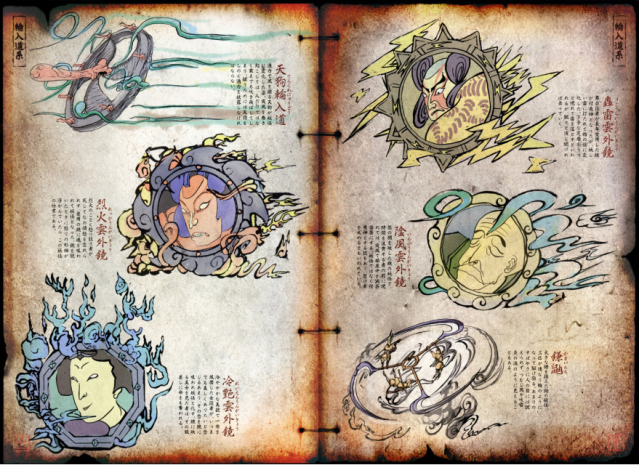
In Ōkami, the Wanyudo isn't represented by the old daimyo, but instead by several versions of Katawaguruma or different things depending on the type of battle you are in.
Well, this entry took a bit longer than expected, but thank you for reading. I hope it has been interesting and informative. Next, I will take a break from yōkai for a while, but the next entry I do about them will deal with yōkai that are less-known or have almost no information available in English, some of the popular yōkai present in Jrock, or perhaps even some of your requests. Until next time!
Your stuff is good!I was searching by information about the Oboroguruma,and here my doubts were elucidated! :)
ReplyDelete